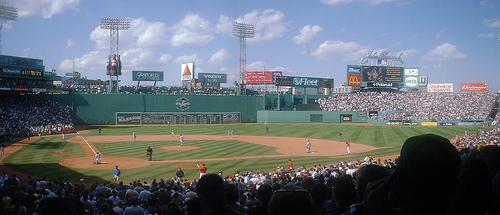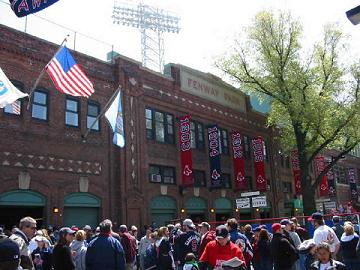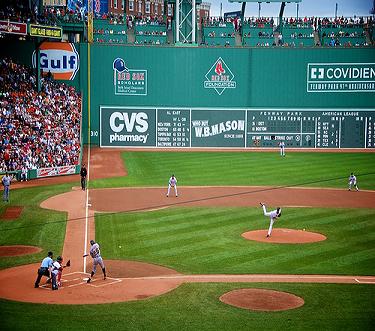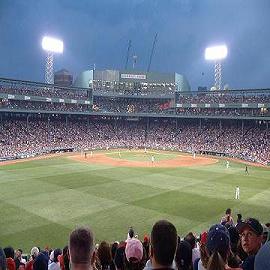Fenway Ballpark, Home of the
Boston Red Sox

Photo Credit

Fenway Ballpark, properly known as Fenway Park, is the oldest ballpark in the major leagues. Home of Red Sox Nation, it opened before the First World War.
In 1903, the Boston Pilgrim won the first-ever World Series (the ballclub later changed the name to the Red Sox in 1907). Boston would go on to win four more World Series titles over the next 15 years (1912, 1915, 1916, and 1918). However, Boston was not able to win another World Series until 2004 and then again in 2007.
Many Sox faithful blamed the failure to win the World Series over 86 years on the sale of Babe Ruth to the New York Yankees on January 3, 1920. The drought would become better known as “The Curse of the Bambino.”
Many great players played in Boston since 1903 such as Ted Williams (greatest hitter of all-time), Cy Young, Babe Ruth, Bobby Doerr, Dom DiMaggio, Tris Speaker, Johnny Pesky, Duffy Lewis, Joe Cronin, Jimmy Collins, to name just a few.
If you are lucky enough to attend a baseball game in Boston, you will be expected to sing Neil Diamond’s Sweet Caroline as loudly as possible in the 8th inning.
Fenway's signature is the 37-foot high wall that extends straight from left field to center field, best known as the Green Monster.
Fenway Ballpark Facts
- Official Name: Fenway Park
- Location: Four Yawkey Way, Boston, MA 02215
- Years: April 20, 1912 - Present
- Capacity: 37,373 (night), 36,945 (day)
- Surface: Natural Grass
- Architect: Osborn Engineering
- Project Cost: $650,000
Fenway Ballpark History
Fenway Ballpark is actually the second home for the Red Sox. In 1901, the Boston Pilgrims became one of the original members of the start-up American League. The Pilgrims played ball at the Huntington Avenue Grounds, now a part of Northeastern University's campus. General Charles Henry Taylor (owner of the Boston Globe) bought the team for his son John.
In 1907, Taylor changed the club's name from the Pilgrims to the Red Sox. In 1910, tired of the leasing arrangement for the Huntington Avenue Grounds, Taylor announced that he would build Fenway Ballpark for his team.

On April 20, 1912, after two rain delays, Fenway Ballpark finally hosted its first “professional” baseball game. The Red Sox defeated the New York Highlanders 7-6 in 11 innings (later known as the Yankees) before 27,000 fans. It would have been front page news if not for the sinking of the Titanic just a few days before.
The intention of Fenway Park's odd dimensions was to keep non-paying customers out of the park. In left field, fans were allowed to sit in front of a steep 10-foot embankment that ran in front of the wall. The Sox' Duffy Lewis was so skilled at playing balls hit to the ledge that it became known as Duffy's Cliff.
Fenway Ballpark remained unchanged until a May 8, 1926 fire destroyed the bleachers along the left field line. John Quinn, the owner at the time, didn’t rebuild the bleachers due to a lack of funds. Left fielders didn't complain since they were able catch foul balls for outs behind the stands.
Tom Yawkey, who bought the club in 1933, began a major overhaul of the park. The revitalization project, however, came to a screeching halt on January 5, 1934 when a second fire left few areas of the ballpark undamaged. Construction crews were able to finish the ballpark in time for the season opener on April 17, 1934 – with a new look.

Concrete bleachers replaced the wood bleachers in centerfield. Duffy's Cliff was levelled somewhat. And a more durable, 37-foot sheet metal structure replaced the 37-foot wooden left field wall.
In 1936, a 23-1/2-foot tall screen was added on top of the wall to prevent baseballs from smashing the windows of buildings on adjoining Lansdowne Street. When the ballclub covered the wall's advertisements with green paint in 1947, Fenway Park's signature feature – the Green Monster – was born.
Three years later, sweet-swinging Ted Williams, a dead-pull left-handed hitter, came to Boston. The following year, the club constructed the bullpens in right field to bring the fence 23 feet closer to home plate for Williams. Williamsburg became the new name for the bullpens.

The ballclub installed sky-view seats at Fenway Park in 1946, added lights in 1947, and in 1976, built the first message board over the centerfield bleachers. In 1988-89, the Red Sox constructed stadium club seats above the grandstand behind home plate, where the former press box was located. Before the 2003 season, the club added 269 seats on top of the Green Monster.
Other than those additions,
Fenway Ballpark
for the most part is unchanged. With one of the last hand-operated scoreboards in baseball, the Green Monster, and the stories of the legends that have played there for more than eight decades, Fenway remains an important link to the baseball's past.
